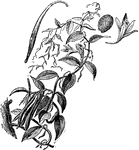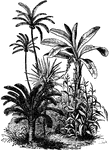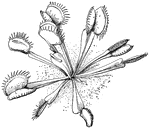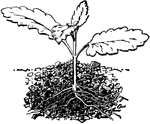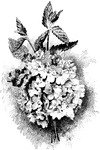234 illustrations of flowers and shrubs including: tansy, tea, thalia, thistle, tickseed tiger lily, toadflax, tobacco, tulip, utricularia, valerian, venus flytrap, verbana, vervain, vine, viola, violet, viper's bugloss, and Virginia creeper

Typhaceae, Pandanaceae, and Naiadaceae Orders
The typhaceae order consists of perennial marsh herbs with creeping rootstocks. The pandanaceae order…

Umbelliferae
"Flower and fruit of Umbelliferae. A, flower of Foeniculum; B, fruit of Heracleum; C, fruit of Heracleum,…
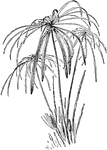
Umbrella Plant
Umbrella plant is the common name of cyperus alternifolius. The plant grows one to four feet tall. The…
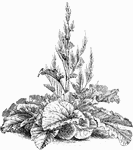
Rheum Undulatum
A plant with dense amounts of leaves. The stems grow up to 5 feet, and are commonly found in Siberia.
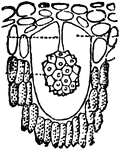
Urostigma Elasticum
"Cellular tissue from leaf of Urostigma elasticum. c, a large cell; r, cystolith, an agglomeration of…
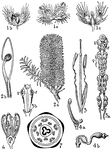
Urticaceae, Loranthaceae, and Olacaceae Orders
Shown are the Urticaceae, Loranthaceae, and Olacaceae orders. Urtica, banksia, protea, phoradendron,…

Utricularia
No leaf-sheaths present; flower cluster consisting of one to several showy, irregular, yellow, or purple…

Utricularia
"Bladder of Ultricularia neglecta, showing at c collar indistinctly seen through walls." — The…

Polypodium Vacciniifolium
A slender wide-creeping fern with grey and/or reddish-brown scales. They are commonly found between…

Valerian
Valerian, the type genus of Valerianaceae; an order of herbs. It is distinguished by opposite leaves…

Valerian
"Valerian is an order of herbs or rarely shrubs belonging to the division of monopetalous dicotyledons…

Valerian
Valerian (Valeriana officinalis, Valerianaceae) is a hardy perennial flowering plant, with heads of…

Valerian Flower
Valerian is a hardy perennial flowering plant, with heads of sweetly scented pink or white flowers.…

Valerian Flower (Longitudinal Section)
An illustration of a longitudinal sectional view of the valerian flower. Valerian is a hardy perennial…
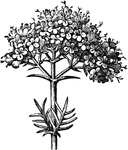
Valerian Inflorescence
Valerian is a hardy perennial flowering plant, with heads of sweetly scented pink or white flowers.…

Valerian Seed with Pappus
An illustration of the valerian seed with attached pappus. In a composite flower, Pappus is the part…

Red Valerian
"Centranthus ruber. 1. a corolla; 2. section of ovary; 3. ripe fruit, with its pappus; 4. cross section…

Valerianella Woodsiana
Of the Valerian family (Valerianaceae), the corn salad (Valerianella Woodsiana).

Vanilla Planifolia
"Vanilla is a genus of epiphytal Orchideæ, natives of tropical America and Asia. They are distinguished…
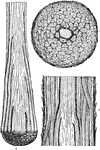
Brazilian Vellozia
"Sections of the stem of a Brazilian Vellozia; 1. transversely; 2, 3. longitudinally." -Lindley, 1853
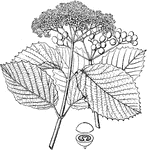
Viburnum Venosum
Shrub belonging to the Viburnum genus, commonly seen in the Northern Hemisphere bearing flower clusters.

Venus Fly Trap
Venus Fly Trap is the common name of dionaea muscipula. The plant is insectivorous, meaning it eats…
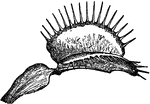
Venus Fly-trap
"Leaf of Venus's Fly-trap (Dionaea muscipula), viewed laterally in its expanded state." — The…

Venus Fly-trap
"Leaf of Venus's Fly-trap (Dionaea muscipula), closed over insect, viewed from the side." — The…
Venus Fly-trap
"Leaf of Venus's Fly-trap (Dionaea muscipula), closed over insect, viewed from above." — The Encyclopedia…
Venus Flytrap
"Dionaea muscipula. 1. its pistil; 2. a sectional view of it showing the placentae; 3. a seed; 4. the…
Venus's Looking-Glass
Of the Bellflower family (Campanulaceae), Venus's looking-glass (Specularia perfoliata).

Verbena
A genus of plant, of which several species are extensively cultivated, some for their lemon-scented,…

Whtie Sand Verbena
"Abronia mellifera; 2. a flower separate; 3. its stamens and pistil; 4. the pistil separate; 5. the…
Narrow-Leaved Vervain
Of the Vervain family (Verbenaceae), the narrow-leaved vervain (Verbena angustifolia).
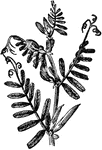
Vetch Plant
"Vetch, Fetch, Fitch, and Tare are terms variously used to indicate the fodder plant. This genus consists…

Vetch Seed Pod
"Vetch, Fetch, Fitch, and Tare are terms variously used to indicate the fodder plant. This genus consists…

Victoria Aster
Victoria aster is one of the most popular varieties of aster. The flowers heads are four inches in diameter.…

Syringa Villosa
This is a northern plant of northern China, featuring oval leaves and a rose type flowers.

Vincetoxicum
"Vincetoxicum officinale. a, root; b, fruit; c, a single seed." — Chambers' Encyclopedia, 1875








